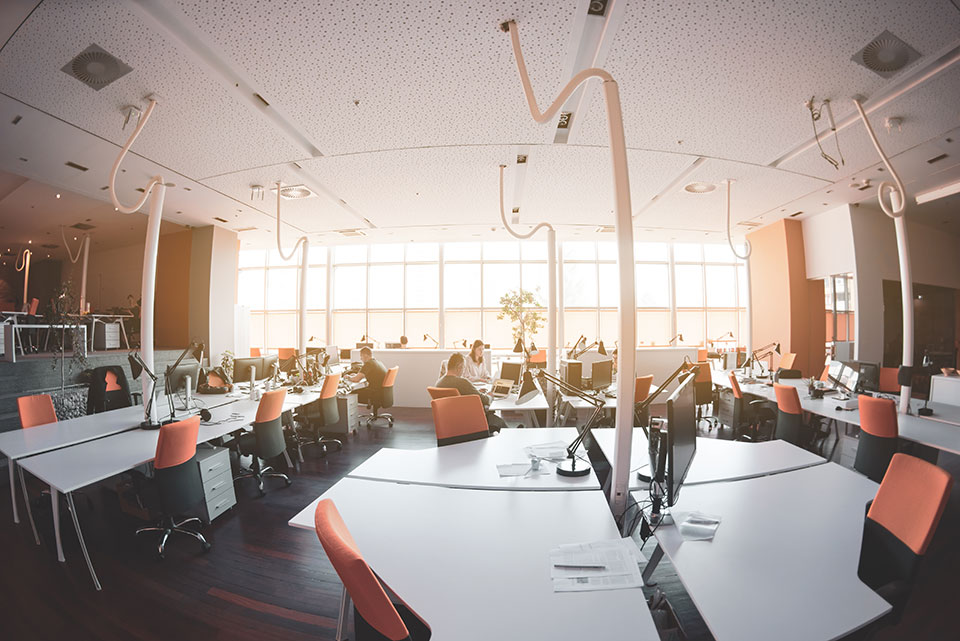Office Spaces are in Flux: Time for Corporate Cultures to be ‘Flex-able’

Office space is in flux; technology already upended traditional work environments, but the pandemic has added an entirely new layer of uncertainty. The challenge for leaders is to make sure their great corporate culture is not in flux; and to make sure it can flex with the times – while thriving in a new fluid office world. Our current landscape gives a deeper meaning to the flexible office space sector, which has been on the rise for some time and is now being accelerated by the impact of COVID-19. According to The Commercial Observer, flexible and coworking spaces are expected to double and even triple in some regions within the next five years.
As the CEO of a SaaS company that provides the technology for flexible workspaces, I am focused on fostering an excellent environment for my team on how to counsel other enterprises to skillfully navigate the revised normal for today’s office. I started my new role at the height of the crisis, so I am painfully aware of my staff and clients’ challenges and sensitivities.
Almost a year into this pandemic, vaccines hold hope and promise for a return to in-person office time. However, today’s CEOs are saddled with the need to understand the essentials of managing risks as we emerge from this crisis. A proactive plan to blend functional areas like Human Resources and IT are critical to optimize the agility needed to manage a diverse and hybrid workforce. Although the way we ‘office’ will forever change, the challenges of building and maintaining exceptional teams remain constant regardless of physical location. While COVID-19 has put us in a time of chaos and catastrophe; it also offers new opportunities.
The forced remote work model has thrown tradition out of the proverbial office window as spaces become de-densified and more people are working at home or closer to home.
Flex-space is a powerful tool to future-proof office space to scale up and down as needed and shape culture. The supply of flexible office space is expected to increase by 21% globally. Additionally, a recent tenant survey from CBRE indicates that 86% of respondents see flexible office space as a critical component of their future real estate strategies.
Corporations in the driver’s seat of real estate choices, must take a long-term approach in planning the needs of their future workforce. What will remain crucial for leaders is the ability to re-examine the new office world in flux and how it will challenge them to keep a great culture in place.
Let’s review what has impacted the evolution of traditional commercial office space to a hybrid office model. Each factor can act as a disruptor or enabler to create a strong culture in 2021 and beyond:
Flexible Office Space. The new normal in office space has shifted from a long-term, physical product to a service-focused asset. This model accommodates high-transaction volumes that can respond to tenant needs like coworking, private offices and shorter-lease terms. Most landlords and employers of choice aren’t standing still. They are increasingly considering flex models – whether utilizing their internal teams or partnering with third-party operators. The reality is that running a flexible workspace operation is not one-size-fits-all, and it is very complex. Technology is a key component to enabling flexible, move-in ready office assets that ultimately increase tenant’s productivity and an employer’s control of the space.
- Disruptor of culture: Flex space, if not done thoughtfully, can result in a loss of a strong corporate identity. People can feel like nomads with no real home with impersonal spaces and too much co-mingling with other companies.
- Enabler of culture: The key to making it successful long-term is to allow workers to have choice and empowerment of where they work. Some older staffers may prefer office locations closer to home to avoid long commutes, while younger staffers may select urban areas to socialize after work. Flex spaces allow for the hub and spoke option. Employers can control the amount of personal space allocated for workers (cubicles with partitions are back in popularity with larger square footage) and ensure that touch-free options and state of the art technology are available at every location, while making sure the technology to collaborate with hybrid workforces is available. The key ingredient to making flex spaces work is keeping it simple and user friendly. Operators and tenants should not rely on internal IT professionals to manage or use the space effectively.
Physical and Digital Security: Employers, especially enterprise organizations, are quickly learning that the security requirements are more important than ever when considering office options. Off the shelf technology products will not suffice. Employers need to utilize industry-leading technology and software that meet a wide range of technical requirements and ‘check’ the critical boxes for physical and digital security. Data breaches need to be prevented, and buildings must be secure to restore confidence and trust for employees returning to work.
- Disruptor of culture: Fear of outages and data breaches aren’t abating. Employers must be proactive in communicating protocols and policies clearly and repeatedly to entice staffers to return to the office.
- Enabler of culture: Employees who are confident that the office is safe, secure, and well-managed will be eager to connect with colleagues and strengthen company culture.
Automation and Technology: There is no one size fits all to power office spaces because it is complicated. Enterprise companies recognize the value of flexible office spaces to manage technology needs and future proof the workspace.
- Technology glitches can be a disruptor of culture: Employers and landlords are not generally in the business of delivering turnkey WIFI, networking, building access, and observability of current office usage. The learning curve is steep to build and manage networks and infrastructure.
- Best-of-breed technology to power flexible office space is an enabler of culture: Companies can immediately unlock workspaces’ value to meet employees’ needs while being recognized as a trusted employer of choice. Smart building access and other automation features can reduce human to human interactions, and save time and money, and foster trust in the office experience. For many companies, state of the art networking and security compliance is mandatory. Enterprise level security is not as simple as coffee shop network security. Corporate offices must exceed the technology of home offices and other worksite locations.
Hybrid Technology: The demand for hybrid technology to accommodate an agile workforce’s requests will be critical to future proof talent demands. Multi-site employers must offer a seamless and secure experience for workers to access buildings, amenities, and collaborative spaces while providing the technology for hybrid working teams to stay connected and be productive. Employers who provide technology to enhance collaboration will have a powerful competitive advantage.
- Disruptor of culture: Technical glitches negatively impact productivity, employee satisfaction, and the bottom line. It is imperative to stay at the forefront of collaboration tools to communicate with global employees simply, quickly, and stress-free.
- Enabler of culture: The needs of a workforce change rapidly daily, so offering secure and trusted collaboration tools keeps the culture healthy.
Like businesses and technology continually need to reinvent themselves to stay relevant, physical offices must take the same approach. With office spaces in flux, companies are challenged to manage the current environment and look towards the future. However, companies with a proactive, agile plan that includes flexibility will ultimately build a more robust and more stable culture. My advice to other CEOs when evaluating your 2021 and beyond office strategy is to become ‘flex-able.’
Written by Jeremy Bernard.
Bring the best of the CEOWORLD magazine's global journalism to audiences in the United States and around the world. - Add CEOWORLD magazine to your Google News feed.
Follow CEOWORLD magazine headlines on: Google News, LinkedIn, Twitter, and Facebook.
Copyright 2025 The CEOWORLD magazine. All rights reserved. This material (and any extract from it) must not be copied, redistributed or placed on any website, without CEOWORLD magazine' prior written consent. For media queries, please contact: info@ceoworld.biz












